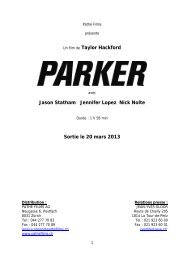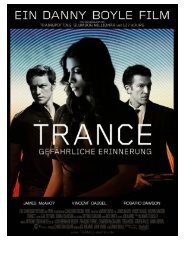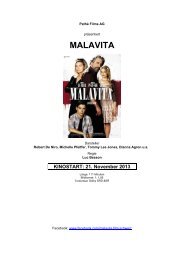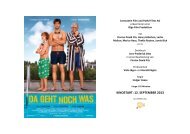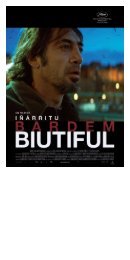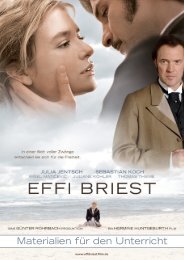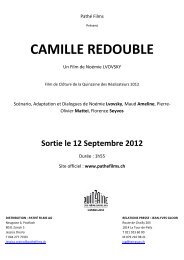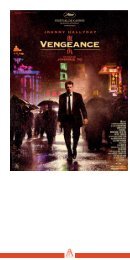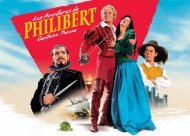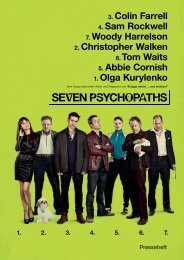aiSling loFTuS - Pathé Films AG Zürich
aiSling loFTuS - Pathé Films AG Zürich
aiSling loFTuS - Pathé Films AG Zürich
You also want an ePaper? Increase the reach of your titles
YUMPU automatically turns print PDFs into web optimized ePapers that Google loves.
The<br />
animation<br />
Ian FitzGibbon, a director with no prior experience in<br />
animation, was stepping into uncharted waters with<br />
Death of a Superhero.<br />
Donald’s drawings, violent and graphic images of sex<br />
and death, bring us inside the mind of a troubled teenager,<br />
a young man with a vivid imagination whose own<br />
life is ebbing away. The drawings tell us of his hopes<br />
and nightmares. To recreate this universe, the film makers<br />
recruited the German animation company, Trixter (Heavy<br />
Metal 2000, X-Men, Captain America), with whom Philipp<br />
Kreuzer had previously worked.<br />
The result is classic artwork: 2D cell animation, rarely<br />
used anymore and far removed from the slickness of<br />
computer-generated productions. In drawing the indestructible<br />
Superhero, the diabolical villain “The Glove”<br />
and the sexy-evil “Nursey Worsey”, Trixter referenced<br />
an extra developed handdrawn style combined with<br />
elements of graffiti. It is a primitive style, rough and unfinished<br />
and somewhat similar to the drawings of a<br />
teenage boy with a vivid imagination and a raw talent.<br />
Alessandro Cioffi (Ninja Assassin, Percy Jackson, Iron<br />
Man 2), visual effects and animation supervisor at Trixter,<br />
whose background in fine art allied to his expertise in<br />
computer graphics and film technique, was the ideal<br />
candidate for Death of a Superhero. Cioffi worked<br />
very closely with Ian FitzGibbon on perfecting the right<br />
tone for the animation sequences, telling Donald’s story<br />
in bursts of animation, pushing the boundaries of the art<br />
as they developed more and more dramatic scenarios<br />
for the characters that hurtle around inside Donald’s<br />
head. “We gave our animation an European sensibility<br />
and a very personal touch of Donald,” says Cioffi. “He uses<br />
markers, brushes – all types of drawing implements.<br />
He’s not copying anyone but just using his tools and<br />
learning by doing. The animation looks a bit dirty and<br />
unaccomplished, unfinished so to speak, as he’s not a<br />
refined artist. It’s not quite manga although the technique<br />
is the same.”<br />
Occasionally both worlds collide – the real life of<br />
Donald’s Dublin and the comic book inside his head.<br />
For the animators slipping between the two worlds had<br />
to be subtly orchestrated.<br />
After months of work, editing and revising, the finished<br />
animation came to life. For Ian FitzGibbon the animation<br />
is not so much the icing on the cake as the key ingredient<br />
that makes the cake different. “The animation is the final<br />
piece of the puzzle,” he says. “The animation changes<br />
the film totally in a way. It adds a whole layer of energy,<br />
colour and action. But ultimately the animation only<br />
serves the story and that’s why it works.”<br />
10 11



